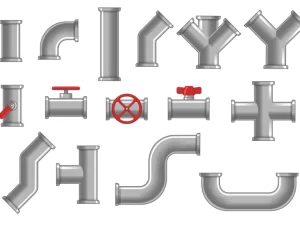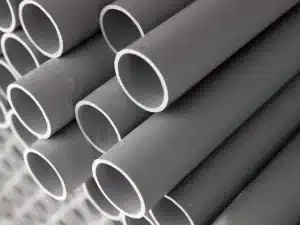Key Factors to Consider When Selecting Oil and Gas Pipes
The energy sector uses oil and gas pipelines to securely deliver crude, natural gas, and refined products over lengthy distances. Industrial procedures must have appropriate pipelines to ensure system safety and extended product life duration. Improper pipeline choices can result in leaks, environmental damage, expensive repair needs, and possibly dangerous situations. Industry leaders must study these essential elements of pipe products and their operating pressure range, environmental factors, and maintenance needs. This article examines oil and gas pipe types alongside essential selection criteria for pipe flange suppliers.
Types of Oil and Gas Pipes
Below, we explore the most commonly used types of oil and gas pipes, their benefits, and where they are used.
Seamless Pipes
Seamless pipes rely on single steel components without adding welding points. The production of hollow tubes begins with the extrusion process, where solid steel billets are first heated and then pushed or pulled to shape the final product.
Benefits of Using Seamless Pipes:
No weak spots since there are no welding seams
Stronger and more durable compared to welded pipes
Can withstand high pressure and extreme temperatures
Suitable for applications where project safety is a priority
Welded Pipes
The welding process for welded pipes involves shaping a flat steel strip or plate into a tube and welding the edges together. Pipe flange suppliers use different welding methods that include:
Electric Resistance Welding (ERW) – Used for medium to high-pressure applications.
Longitudinal Submerged Arc Welding (LSAW) – Used for large-diameter pipes.
Spiral Submerged Arc Welding (SSAW) – Commonly used for pipelines that transport fluids over long distances.
Benefits of Using Welded Pipes:
More affordable than seamless pipes
Available in larger diameters
Suitable for low to medium-pressure applications
Easier to manufacture in bulk
Carbon Steel Pipes
Carbon steel pipes are manufactured using iron and carbon as their primary materials. They serve oil and gas operations because they are durable, strong, and affordable.
Benefits of Carbon Steel Pipes:
High strength and durability
Affordable and widely available
Can withstand high temperatures and pressure
Suitable for both onshore and offshore applications
Stainless Steel Pipes
Stainless steel pipes contain chromium, which makes them highly resistant to rust and corrosion. These pipes are often used in environments where they will be exposed to high moisture levels, chemicals, or extreme temperatures.
Benefits of Stainless Steel Pipes:
Excellent corrosion resistance
Long-lasting and low-maintenance
Can handle both high and low temperatures
Suitable for transporting liquid and gas
Alloy Steel Pipes
Alloy steel pipes are made from chromium, molybdenum, and nickel, which make them resistant to industrial use. These elements make the pipes more powerful, heat-protective, and better suited for extreme conditions.
Benefits of Alloy Steel Pipes:
Can withstand very high temperatures
More durable than regular carbon steel pipes
Resistant to corrosion and wear
Suitable for heavy-duty applications
Key Factors to Consider
Several factors should be considered when making this decision. To enhance pipeline durability, choosing high-quality components from reputable pipe flange suppliers in the UAE is crucial. Here are the most important factors, explained in simple terms:
Pressure and Temperature Requirements
Each oil and gas pipeline operates under different pressure and temperature settings. Some pipelines are used in high-pressure projects and need strong materials to prevent wear and tear. Pipelines also operate in extremely rigid and icy environmental conditions. Crossing pipes with unsuitable materials can result in permanent weakening.
Corrosion Resistance
These pipelines transport contents that induce corrosion, such as saltwater, acidic gases, and various chemical substances. The onset of pipe corrosion leads to various issues, including leaks that can progress into complete fractures, requiring costly repairs and creating unsafe conditions. The key measure to avoid this situation is to select pipes from resistant materials.
Material Strength and Durability
Different pipe materials exhibit varying strengths, as each material used in pipe production influences its structural integrity. The strength of materials varies, with some offering superior resistance to high pressure, while others remain lightweight yet durable.
For example:
Carbon steel pipes are strong and commonly used for high-pressure applications.
Composite pipes are lighter but still durable, making them easier to install and transport.
Pipeline Location and Environment
Pipeline installation sites determine the selection of pipe materials. The materials used for offshore pipelines must resist permanent seawater interaction combined with heavy pressure and demanding conditions. Pipelines on land encounter various operating obstacles, including soil corrosion, temperature variations, and water exposure.
Cost and Budget
Budget is always a key factor in any oil and gas project. Some pipes are more expensive but offer better strength and durability. For example:
Seamless pipes are more expensive but stronger, making them ideal for high-pressure applications.
Welded pipes are more affordable and widely used for many onshore projects where extreme strength is not always necessary.
Installation and Maintenance Requirements
Certain types of pipes simplify the installation process with their reduced maintenance needs. Installation expenses and future maintenance requirements must be evaluated because they accumulate substantial costs. Composite pipes are lightweight, and their simple handling characteristics speed up installation activities. The higher purchase cost of stainless steel pipes leads to budget savings because they require less maintenance during their long operational period.
Special Considerations for Offshore vs. Onshore Applications
Industrial sites can present different challenges during operations. Multiple factors must be considered when choosing application pipes to ensure safety and smooth efficiency.
Offshore Pipelines
Offshore pipelines operate underwater and carry oil and gas to processing industrial facilities. Due to harsh marine conditions, these pipelines can be exposed to high water pressure, saltwater corrosion, and wear and tear damage.
Key Considerations for Offshore Pipelines:
Must be corrosion-resistant (stainless steel or composite pipes are preferred)
Should withstand high pressures and rough sea conditions
Need to be protected against external damage from waves and marine life
Onshore Pipelines
Onshore pipelines transport oil and gas across land. Depending on the terrain and safety requirements, they are often buried underground or placed above ground.
Key Considerations for Onshore Pipelines:
Must be strong enough to withstand soil movement and external pressures
Should be coated or insulated to prevent corrosion from moisture and chemicals in the soil
Must adhere to local environmental and safety rules
Conclusion
Pipeline selection requires carefully examining industry requirements, application pressure demands, and fluid elements. Various protective mechanisms can help overcome pipeline challenges in offshore and onshore environments. Quality pipelines from reliable pipe flange suppliers in the UAE protect performance and durability to minimize repair expenses.
FAQs
Q1: What is the best material for oil and gas pipelines?
Pipeline material selection depends on their transportation substances and environmental operating conditions. Carbon steel is the top selection because of its strength and low cost. Stainless steel provides the most suitable performance in environments with increased moisture content and chemical presence.
Q2: How do I determine the right pipe thickness for my application?
The three determining factors for pipe thickness are pressure levels, material temperature, and the substances that flow through it. Engineers refer to industry rules to establish the most secure pipe thickness. Pressure levels determine whether a pipeline needs thick pipes or can operate using thinner ones.
Q3: Why are seamless pipes preferred for high-pressure applications?
The complete lack of welds in seamless pipes gives them superior durability for managing high-pressure systems. A single continuous metallic structure of seamless pipes reduces leakage and cracking risks. The top selection of pipelines for safe oil and gas transport represents this material.
Q4: What coatings are used to prevent pipeline corrosion?
Rust prevention and protection against damage require protective coatings on pipeline systems. The pipeline industry employs different coatings, including epoxy, polyethylene, and fusion-bonded epoxy. Hydrostatic and weather-related damage finds protection through these protective layers.
Q5: How do API and ASME standards impact pipe selection?
API (American Petroleum Institute) and ASME (American Society of Mechanical Engineers) set important rules for pipe quality and safety. Pipes must be approved by API and ASME standards to demonstrate sufficient capabilities to resist environmental changes and maintain adequate pressure and temperature.
Q6: What factors affect the lifespan of oil and gas pipes?
Different aspects determine the duration of the pipeline’s existence. Pipe material quality, protective coatings, weather conditions, and proper maintenance determine the lifespan. Pipeline inspections, combined with repair procedures, can prevent problems from developing.







